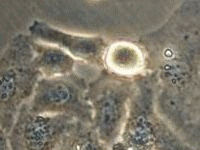Tricyclic Antidepressant Imipramine May Combat Small Cell Lung Cancer (Stanford University School of Medicine)
 |
| English: Cancer cells photographed by camera attached to microscope in time-lapse manner. (Photo credit: Wikipedia) |
Excerpts:
"...The phase-2 trial is now recruiting participants with small-cell lung cancer and other, similar conditions like aggressive gastrointestinal neuroendocrine cancers. The “repositioning” of an existing drug to treat a disorder other than the one for which it was originally approved is an example of how extremely large genetic and biological databases are changing the face of medicine."
"...Specifically, the drugs activated a cellular self-destruct pathway that killed the cancer cells."
"...The pipeline works by scanning the hundreds of thousands of gene-expression profiles (gathered by multiple researchers and stored in large databases) across many different cell types and tissues — some normal and some diseased, some treated with medications and some not. Alone, these profiles may not mean much to any one investigator or group, but when viewed together, researchers can pick out previously unsuspected patterns and trends."
"Jahchan tested the effect of a tricyclic antidepressant called imipramine on human small-cell lung cancer cells grown in the laboratory and growing as tumors in laboratory mice. She found that the drug was able to potently activate a self-destruction pathway in the cancer cells and to slow or block metastases in the animals. The drug maintained its effectiveness regardless of whether the cancer cells had previously been exposed, and become resistant, to traditional chemotherapy treatments. Another drug, an antihistamine called promethazine, identified by the bioinformatics screen, also exhibited cancer-cell-killing abilities."
"Further investigation showed that the drugs appear to work through a class of molecule on the cancer cells’ surfaces called G-protein-coupled receptors, but the researchers are continuing to investigate exactly how the drugs specifically kill neuroendocrine cancer cells."
See more at: http://med.stanford.edu/ism/2013/september/antidepressant.html#sthash.OzJhnFka.dpuf
Link to full article here.
Read more...

















